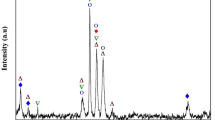Abstract
Wear mechanisms of three Ag–Cu eutectic alloy samples cooled at different rates from the melt have been investigated by friction force microscopy. The eutectic phase exhibits a lamellar structure where the interlamellar thickness decreases with increasing cooling rate. The hardness of the samples decreases with decreasing thickness of the lamellae. In the low normal force regime (Fn ≤ 1000 nN) friction is governed by shearing and the relevant contact area can be well described by the Johnson–Kendal–Roberts model. At higher normal force values, the surface is worn, and friction can be described by the ploughing friction coefficient. A ploughing friction coefficient is determined, which is positively correlated with the hardness of the Ag–Cu eutectic alloy samples cooled at different rates, while the wear volume negatively correlates with the hardness.









Similar content being viewed by others
References
Bowden FP, Tabor D (2008) The friction and lubrication of solids. Oxford University Press, Oxford
Rigney DA (1988) Sliding wear of metals. Ann Rev Mater Sci 18:141–163
Ren F, Bellon P, Averback RS (2016) Nanoscale self-organization reaction in Cu–Ag alloys subjected to dry sliding and its impact on wear resistance. Tribol Int 100:420–429
Greiner C, Liu Z, Strassberger L, Gumbsch P (2016) Sequence of stages in the microstructure evolution in copper under mild reciprocating tribological loading. ACS Appl Mater Interfaces 8:15809–15819
Hosford WF (2010) Mechanical behavior of materials, 2nd edn. Cambridge University Press, Cambridge
Cai W, Bellon P (2013) Subsurface evolution and deformation mechanism of Ag–Cu eutectic alloy after dry sliding wear. Wear 303:602–610
Ko HE, Park HW, Jiang JZ, Caron A (2018) Nanoscopic wear of face centered cubic metals. Acta Mater 147:203–212
Nonnenmacher M, Greschner J, Wolter O, Kassing R (1991) J Vac Sci Technol B 9:1358–1362
Gnecco E, Bennewitz R, Pfeiffer O, Socoliuc A, Meyer E (2005) Friction and wear on the atomic scale. In: Bhushan B (ed) Nanotribology and nanomechanics: an introduction. Springer, Berlin
In this work we used the version R2017b. Matlab is manufactured and distributed by MathWorks, U.S.A
Johnson KL (1985) Contact mechanics. Cambridge University Press, Cambridge
Johnson KL, Kendall K, Roberts AD (1971) Surface energy and the contact of elastic solids. Proc R Soc Lond Ser A 324:301–313
Oliver WC, Pharr GM (2004) Measurement of hardness and elastic modulus by instrumented indentation: advances in understanding and refinements to methodology. J Mater Res 19:3–20
Lubarda VA (2003) On the effective lattice parameter of binary solution. Mech Mater 35:53–68
Nevolin VK (1983) Theoretical strength of metals. Strength Mater 15:388–390
Clopet CR, Cochrane RF, Mullis AM (2013) The origin of anomalous eutectic structures in undercooled Ag–Cu alloy. Acta Mater 61:6894–6902
Yu Y, Mullis AM, Cochrane RF (2016) Rapidly solidified Ag–Cu eutectics: a comparative study using drop-tube and melt fluxing techniques. IOP Conf Ser Mater Sci Eng 117:010253-1–6
Caron A, Bennewitz R (2015) Lower nanometer-scale size limit for the deformation of a metallic glass by shear transformations revealed by quantitative AFM indentation. Beilstein J. Nanotechnol. 6:1721–1732
Cordero ZC, Knight BE, Schuh CA (2016) Six decades of the Hall-Petch effect—a survey of grain-size strengthening studies on pure metals. Int Mater Rev 61:495–512
Yamakov V, Wolf D, Phillpot SR, Mukherjee AK, Gleiter H (2004) Deformation—mechanism map for nanocrystalline metals by molecular dynamics simulation. Nat Mater 3:43–47
Misra A, Kung H (2001) Deformation behavior of nanostructured metallic multilayers. Adv Eng Mater 3:217–222
Schweitz KO, Chevallier J, Bottiger J, Matz W, Schell N (2001) Hardness in Ag/Ni, Au/Ni, and Cu/Ni multilayers. Philos Mag A Phys Condens Matter Struct Defect Mech Prop 81:2021–2032
Misra A, Hirth JP, Hoagland RG (2005) Length-scale dependent deformation mechanisms in incoherent metallic multilayered composites. Acta Mater 53:4817–4824
Hoagland RG, Kurz RJ, Henager CH (2004) Slip resistance of interfaces and the strength of metallic multilayered composites. Scr Mater 50:775–779
Kingstedt OT, Eftink BP, Robertson IM, Lambros J (2016) Acta Mater 105:273–283
Eftink BP, Li A, Szlufarska I, Robertson IM (2016) Interface mediated mechanisms of plastic strain recovery in a Ag–Cu alloy. Acta Mater 117:111–121
Eftink BP, Li A, Szlufarska I, Mara NA, Robertson IM (2017) Deformation response of AgCu interfaces investigated by in situ and ex situ TEM straining and MD simulations. Acta Mater 138:212–223
Acknowledgements
This research was supported by KOREATECH’s Education and Research Promotion Program in 2018. The authors thank Prof. S.J. Kim from KoreaTech for allowing us to prepare samples by arc-melting and melt-spinning. X.Q.P. and R.B. are grateful to Prof. E. Arzt for his continuous interest and support of this work.
Author information
Authors and Affiliations
Corresponding author
Additional information
Publisher's Note
Springer Nature remains neutral with regard to jurisdictional claims in published maps and institutional affiliations.
Rights and permissions
About this article
Cite this article
Kwon, S.K., Kim, H.D., Pei, X.Q. et al. Effect of cooling rate on the structure and nanotribology of Ag–Cu nano-eutectic alloys. J Mater Sci 54, 9168–9184 (2019). https://doi.org/10.1007/s10853-019-03533-5
Received:
Accepted:
Published:
Issue Date:
DOI: https://doi.org/10.1007/s10853-019-03533-5




